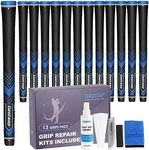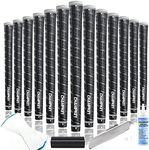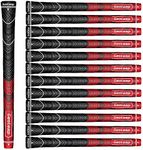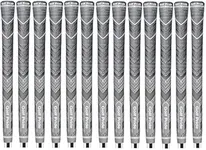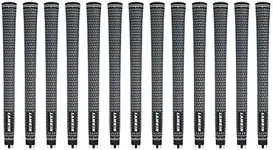Buying Guide for the Best Golf Grips
Choosing the right golf grip is an important step in improving your game and comfort on the course. The grip is the only part of the club you actually touch, so it affects your control, feel, and even your swing consistency. When picking a golf grip, you should consider your hand size, playing conditions, and personal preferences for feel and texture. Understanding the key specifications will help you find a grip that enhances your performance and enjoyment.Grip SizeGrip size refers to the thickness of the grip and is crucial because it affects how your hands interact with the club. If the grip is too small, your hands may become too active, leading to hooks or inconsistent shots. If it's too large, it can restrict hand movement and cause slices. Grip sizes are generally divided into undersize, standard, midsize, and oversize/jumbo. To pick the right size, measure your hand or try different sizes to see which feels most comfortable and allows you to swing naturally. People with smaller hands often prefer undersize or standard, while those with larger hands may benefit from midsize or oversize grips.
MaterialGolf grips are made from various materials, such as rubber, synthetic compounds, or leather. The material affects the grip's feel, durability, and performance in different weather conditions. Rubber grips are soft and tacky, providing good comfort and control, while synthetic grips can offer extra durability and weather resistance. Leather grips are traditional and provide a classic feel but may require more maintenance. If you play in wet or humid conditions, look for materials that maintain traction when damp. Your choice should depend on your comfort preference and the typical weather where you play.
TextureTexture refers to the surface pattern or design of the grip, which influences how securely you can hold the club. Some grips have a smooth surface, while others have pronounced patterns or ridges for extra traction. More texture can help prevent slipping, especially if your hands sweat or you play in rain, but too much texture might feel rough or uncomfortable for some. If you want a softer feel, go for smoother grips; if you need more control or play in challenging conditions, a more textured grip may be better.
FirmnessFirmness describes how hard or soft the grip feels in your hands. Softer grips can absorb more shock and feel more comfortable, which is helpful for players with joint pain or those who prefer a cushioned feel. Firmer grips provide more feedback and control, which some experienced players prefer for precision. If you have sensitive hands or want more comfort, choose a softer grip. If you value feedback and control, a firmer grip might suit you better.
TaperTaper refers to how the grip's thickness changes from the top (butt end) to the bottom. Traditional grips are thicker at the top and thinner at the bottom, while reduced-taper or non-tapered grips maintain a more consistent thickness. Less taper can help promote a more even grip pressure and may benefit players who struggle with overactive hands. If you want a traditional feel, stick with standard taper; if you want to reduce hand action or have a more consistent grip, consider a reduced-taper grip.
Weather ResistanceWeather resistance is about how well the grip performs in different conditions, such as rain or humidity. Some grips are designed to maintain traction and feel even when wet, using special materials or surface patterns. If you often play in wet or humid environments, look for grips labeled as all-weather or moisture-resistant. If you mostly play in dry conditions, this may be less of a concern.
